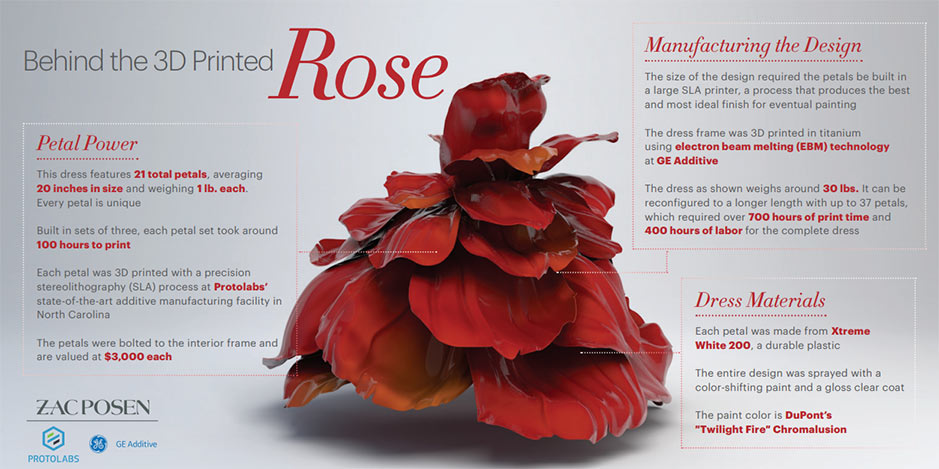3D Printing Has a Glamorous New Dimension: High Fashion
The promise of 3D printing continues to make headlines, this time in the world of high fashion. Industrial-grade 3D printing (additive manufacturing) made its couture debut on Monday (May 6) when four gowns and a head-dress featuring 3D-printed elements and structures were unveiled at the Met Gala.
The garments and accessories, worn at the annual fundraising event for the Metropolitan Museum of Art in New York, were the result of an uncommon collaboration by noted designer Zac Posen, GE Additive, and Protolabs. The fashions were worn by British supermodel Jourdan Dunn, and actresses Nina Dobrev, Katie Holmes, Julia Garner, and Deepika Padukone.
Less Terminator, More Cinderella
Over the past six months, Posen and his creative team worked with design engineers from GE Additive and Protolabs, an unlikely tech-meets-glam collaboration that resulted in sophisticated, lavish looks. In the past, any 3D-printed fashion that had been produced focused on basic geometries, producing a harsh, science fiction look.
By contrast, Posen’s “whimsical design language is more Cinderella than Terminator,” explained Eric Utley, Protolabs applications engineer who worked closely with Posen and his design team on the project.
Posen brought his clean, elegant, classic approach to design the garments around the concept of freezing natural objects in motion. “3D printing holds lots of potential for the future of fashion,” Posen told Marie Claire. “It allows customization, precision, and scaling that cannot be created by hand. I think it will allow designers to really push the boundaries of fashion and create elements in their designs that couldn’t have been achieved before.”
On his design theme of nature and natural objects for the Met Gala gowns, Posen told the New York Times: “Mother Nature can be simple, abstract, challenging, and definitely campy, in ways that are surprising, shocking…You can’t beat Mother Nature. You can just homage.”
Jourdan Dunn wore a custom rose gown, which included 21 printed, stand-alone petals and front and back bodice petals. The petals are fastened in place by a modular titanium cage, which is invisible from the outside. The printing and finishing of the gown took more than 1,100 hours. Nina Dobrev wore a custom-printed bustier dress. The bustier is a clear, printed dress with four-piece assembly for custom fit. The interior was designed to perfectly match Dobrev’s body. Katie Holmes wore a custom Posen gown with a 3D-printed palm leaf collar accessory. The pearlescent purple palm leaves were draped over the shoulders and attached to the gown at the neckline. Julie Garner accented her custom Posen gown with an intricate, 3D-printed vine headpiece. Deepika Padukone wore a custom Posen metallic pink lurex jacquard gown that included 3D-printed embroidery sewn on to the gown.

Behind the Fashion: Technology and Material
The universe of 3D printing and what can be produced with its technology seems boundless: fuel nozzles for jet engines and other aerospace components, car motor mounts and other automotive and marine parts, customized surgical tools, patient-specific medical implants, and so on. Fashion presents yet another new frontier. Accordingly, it was both exciting and challenging for design engineers and others at GE Additive and Protolabs to collaborate on a project in the fashion industry. At the same time, Posen and his team had to adjust to working with CAD models instead of relying solely on sketches and draping fabric on a mannequin or model.
Several 3D printing processes were used, and most of the items were manufactured at Protolabs’ U.S. additive manufacturing facility near North Carolina. The clear bustier dress worn by Dobrev was made at Protolabs’ Feldkirchen, Germany facility. The titanium cage made for Dunn’s rose gown was printed at the GE Additive Technology Center in Cincinnati, Ohio.
Stereolithography (SLA) was used for most of the items, although the headpiece worn by Garner was printed with Multi Jet Fusion (MJF), and the titanium cage was made using GE Additive’s metal printing.
And the material used?
The petals on the rose gown worn by Dunn are made of Accura Xtreme White plastic. The titanium cage that fastened the petals are made of Ti-64.The bustier worn by Dobrev is made of Somos Watershed XC11122 plastic. The leaf collar accessory worn by Holmes is made of Accura 60 plastic. Garner’s headpiece is made of Nylon 12 plastic. And Padukone’s gown embroidery is made of Accura 5530 plastic. Protolabs’ proprietary MicroFine Green™ resin and nylon was also used.
On Tuesday in New York, Protolabs, GE Additive, and Zac Posen hosted a luncheon that featured garment viewing, film screening, and a panel discussion, which included Posen and Protolabs’ Utley, who talked about this uncommon collaboration and how fashion and tech are colliding to create exciting new possibilities.






